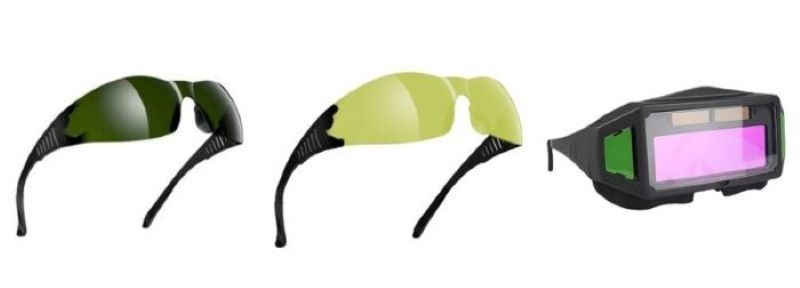Safety goggles are made similarly in structure to regular glasses, but they’re made with specialized materials to make them more durable and protective. Safety goggles protect your eyes from a myriad of potential vision hazards. We’re talking UV rays, strikes, scrapes, burns, splashes and spills, and even blue light from your favorite devices. In this blog by SISCO, we will comprehensively explain the definition, materials used, functions, major types, application scenarios associated with Safety goggles, helping readers build a complete and systematic understanding.
Basic of Safety goggles
Safety goggles offer all-around protection for your eyes. These are the eyewear pieces you remember from lab classes in school. They are large, fit over your entire eye area, and offer full optical protection from airborne pathogens, splashes, spills, and flying objects. Safety goggles form an airtight seal on your eye area, which may be necessary for some professions. Usually, safety goggles have an adjustable rubber strap that fits around the head. Safety goggles can be worn with corrective frames as they will fit over the glasses and do not have arms that would interfere with the arms of your corrective frames.
What are Safety Goggles made of
The material with which your safety glasses are made may not include unicorn hair and magic, but that doesn’t mean they don’t possess some serious other-worldly powers. Any material that can survive a weighted, high-speed impact without shattering is impressive, to say the least. Safety glasses often have lenses and frames made from the same material, but sometimes, the material varies from lens to frame. As such, we'll break down our inspection of materials into two parts: lens material and frame material.
Types of Safety Goggles
Our eyes are exposed to numerous hazards daily, ranging from flying debris and chemicals to harmful UV rays. General safety glasses are designed to shield your eyes from these potential dangers, preventing injuries and maintaining optimal eye health. The type of safety eye goggles you need depends on your level of exposure to chemicals and fumes. These are the three most common options that provide chemical and impact protection without interfering with your employees’ vision: Direct vented goggles, Indirect vented goggles and Non-vented goggles.

Function of Different Safety Goggles
- Direct vented goggles allow the direct flow of air into the goggle. The openings in the vented portion of the goggles exclude spherical objects that are 0.06 inches (1.5 millimeters) in diameter or greater. In cases where impact is the hazard and a splash or vapor hazard does not exist, a direct vented goggle can be used as an appropriate level of protection.
- Indirect vented goggles provide protection from splash entry by a hooded or covered vent. The vented portion of the goggle is designed so that no direct straight-line passage from the exterior to the interior of the goggle exists. The purpose of the indirect venting is to limit or prevent the passage of liquid splash into the goggle. In cases where chemical splash is a hazard, indirect vented goggles should be selected as appropriate protection.
- Non-vented goggles have no venting of any kind and offer protection against the passage of dust, mist, liquid and vapors. For applications where chemical vapor is the hazard, a non-vented goggle will be required protection. Non-vented goggles are NOT gas-proof goggles.
When selecting the appropriate goggle for your workplace, you must first perform a workplace hazard assessment. If eye and face workplace hazards are present, you must determine when, where and what type of eye and face protection is required.
Applications of Safety Goggles
- Industrial Work Environments: Safety goggles are essential for protecting workers in environments such as manufacturing, construction, metal fabrication, and mining, where eye hazards from flying debris, dust, and machinery are common.
- Automotive and Repair Work: In auto repair, plumbing, and woodworking, safety goggles shield the eyes from sparks, tools, chemicals, and other potential hazards.
- Agriculture and Landscaping: Workers involved in agricultural tasks or landscaping use safety goggles to protect against dust, debris, chemicals, and other elements that could cause eye injuries.
- Healthcare and Medical: In healthcare settings, safety goggles are used to protect against biological and chemical exposures that could potentially harm the eyes.
- Household Tasks: Safety goggles should be worn during household tasks such as lawn mowing, chopping wood, or using strong cleaning agents to prevent accidental eye injuries.
- Chemical or High-Risk Work: Any job involving exposure to chemicals, vapors, or airborne particulates requires safety goggles for eye protection.
- Protection for Prescription Glasses Wearers: For those who wear prescription glasses, safety goggles with built-in prescription lenses are the safest option to avoid issues with fit or face seal when wearing regular glasses underneath.
Conclusion
In essence, safety goggles are far more than just protective accessories—they are a critical line of defense for eye health across diverse scenarios. From their specialized materials ensuring durability to the three core types (direct vented, indirect vented, non-vented) tailored to different hazards, they address risks ranging from flying debris to chemical vapors. Whether in industrial sites, healthcare settings, or even during household chores, choosing the right pair based on a thorough hazard assessment is key to maximizing protection. By understanding their full value, we can better safeguard our vision in the face of daily and occupational eye threats. There are different types of goggles on SISCO: laser protective goggles, anti-blue light goggles, welding safety goggles, etc. Please contact us if you would like to get more information about goggles. Welcome to the SISCO Online Store to purchase safety goggles.

